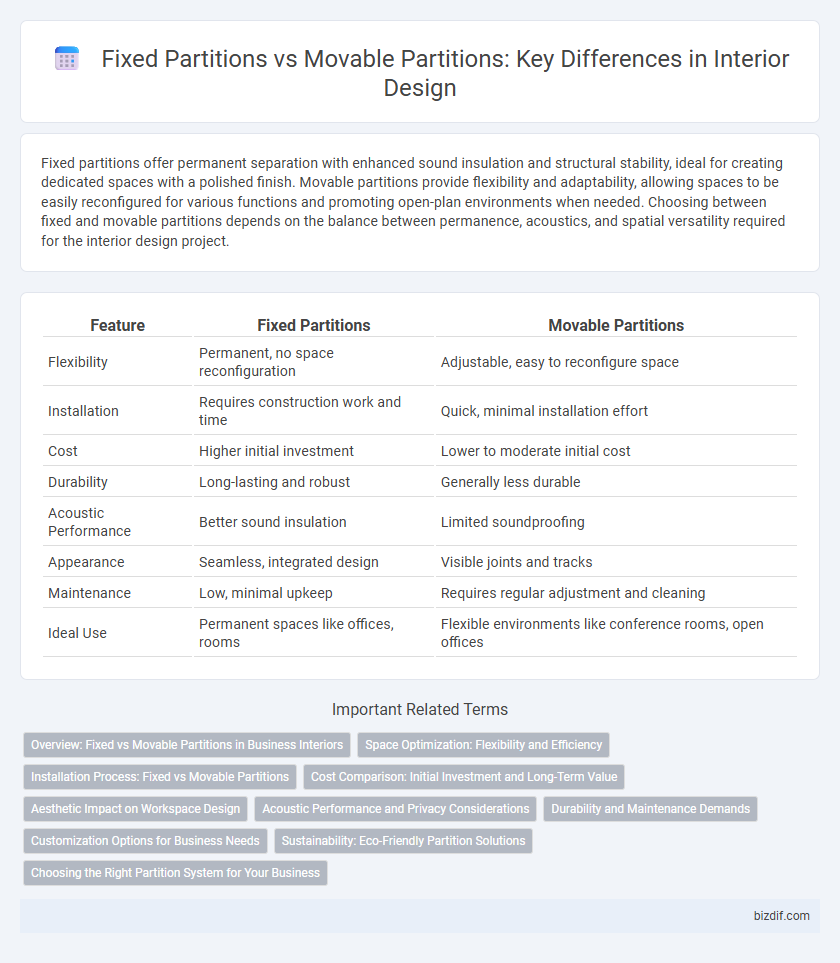Fixed partitions offer permanent separation with enhanced sound insulation and structural stability, ideal for creating dedicated spaces with a polished finish. Movable partitions provide flexibility and adaptability, allowing spaces to be easily reconfigured for various functions and promoting open-plan environments when needed. Choosing between fixed and movable partitions depends on the balance between permanence, acoustics, and spatial versatility required for the interior design project.
Table of Comparison
| Feature | Fixed Partitions | Movable Partitions |
|---|---|---|
| Flexibility | Permanent, no space reconfiguration | Adjustable, easy to reconfigure space |
| Installation | Requires construction work and time | Quick, minimal installation effort |
| Cost | Higher initial investment | Lower to moderate initial cost |
| Durability | Long-lasting and robust | Generally less durable |
| Acoustic Performance | Better sound insulation | Limited soundproofing |
| Appearance | Seamless, integrated design | Visible joints and tracks |
| Maintenance | Low, minimal upkeep | Requires regular adjustment and cleaning |
| Ideal Use | Permanent spaces like offices, rooms | Flexible environments like conference rooms, open offices |
Overview: Fixed vs Movable Partitions in Business Interiors
Fixed partitions in business interiors offer permanent, sturdy separation of spaces, enhancing sound insulation and structural stability. Movable partitions provide flexible room configurations, allowing businesses to adapt spaces quickly to changing needs without extensive renovations. Selecting between fixed and movable partitions depends on factors like desired permanence, acoustic requirements, and spatial versatility.
Space Optimization: Flexibility and Efficiency
Fixed partitions provide stable and soundproof spaces ideal for permanent room divisions, optimizing space for dedicated functions. Movable partitions offer flexibility by allowing rapid reconfiguration to accommodate changing needs, maximizing efficiency in dynamic environments. Choosing between fixed and movable partitions depends on balancing long-term usage with adaptability for space optimization.
Installation Process: Fixed vs Movable Partitions
Fixed partitions require a more intensive installation process involving structural modifications, such as securing frames to floors and ceilings, which often necessitates professional labor and longer project timelines. Movable partitions offer a simplified and flexible installation that typically involves modular components, allowing for quicker setup and easier adjustment or relocation without extensive construction. This streamlined process makes movable partitions ideal for dynamic interior spaces requiring frequent layout changes.
Cost Comparison: Initial Investment and Long-Term Value
Fixed partitions usually require a higher initial investment due to construction materials and installation labor, while movable partitions offer lower upfront costs and greater flexibility. Over time, fixed partitions provide durability and minimal maintenance expenses, contributing to long-term value in permanent layouts. Movable partitions incur ongoing costs related to adaptability and potential replacements but can optimize space usage and reduce renovation expenses.
Aesthetic Impact on Workspace Design
Fixed partitions create a consistent and cohesive aesthetic by establishing permanent boundaries that enhance the architectural integrity of a workspace. Movable partitions offer flexibility, allowing dynamic reconfiguration of space, which supports evolving design themes and can introduce varied textures and materials to refresh the visual environment. Both impact the workspace atmosphere significantly, with fixed partitions emphasizing stability and structure while movable partitions encourage adaptability and creativity in interior design.
Acoustic Performance and Privacy Considerations
Fixed partitions provide superior acoustic insulation due to their solid construction, effectively reducing sound transmission between spaces and enhancing privacy in office or residential designs. Movable partitions offer flexibility but typically have lower soundproofing capabilities, making them suitable for temporary or adaptable layouts where privacy needs are moderate. Selecting between fixed and movable partitions depends on balancing acoustic performance requirements with spatial versatility and design objectives.
Durability and Maintenance Demands
Fixed partitions typically offer superior durability due to their solid construction with materials like drywall or brick, requiring minimal maintenance over time. Movable partitions, often made from lightweight materials such as aluminum frames with fabric or glass panels, demand more frequent care to ensure operational smoothness and longevity. Regular cleaning and occasional repairs are essential for maintaining movable partitions' functionality, whereas fixed partitions mainly require periodic inspection for structural integrity.
Customization Options for Business Needs
Fixed partitions offer limited customization, often requiring structural changes to modify layout, making them suitable for businesses with stable space requirements. Movable partitions provide flexible customization options, enabling quick reconfiguration of office layouts to adapt to changing business needs such as team expansion or privacy levels. Choosing between fixed and movable partitions hinges on balancing permanence with adaptability for optimized interior design solutions.
Sustainability: Eco-Friendly Partition Solutions
Fixed partitions offer long-term durability with minimal maintenance, reducing waste over time and contributing to sustainable building practices. Movable partitions provide flexibility, allowing spaces to be reconfigured without demolition, which limits material consumption and supports eco-friendly interior design. Choosing recyclable materials for both partition types enhances sustainability by promoting resource efficiency and reducing environmental impact.
Choosing the Right Partition System for Your Business
Fixed partitions provide permanent, sturdy divisions ideal for defining distinct workspaces with enhanced sound insulation and structural stability, suitable for long-term office layouts. Movable partitions offer flexible, reconfigurable solutions that enable businesses to adapt spaces quickly for meetings, collaborative projects, or evolving operational needs. Selecting the right partition system depends on factors like budget, desired flexibility, acoustic requirements, and the frequency of space reconfiguration in your commercial environment.
Fixed partitions vs Movable partitions Infographic

 bizdif.com
bizdif.com